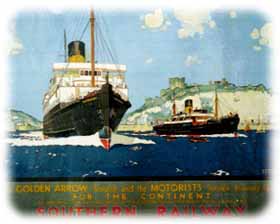Southern Railway Poster
Poster, Kenneth Shoesmith, 1936
 Poster advertising the ferry services run by the Southern Railway.
Poster advertising the ferry services run by the Southern Railway.
The Canterbury was launched in 1929 as the ship for the Golden Arrow luxury London to Paris service run by Southern Railway. Autocarrier was the first purpose-built car ferry, launched by Southern Railway in response to Townsend's 'Artificer', in 1931.
Passenger traffic had reached such proportions that trains and ferries were often overcrowded and queues at Customs, etc., were huge. To improve this the luxury first-class service was introduced, London to Paris, using an English Pullman train the Golden Arrow and a French counterpart the Fleche d'Or. Passengers not only had their own train and ship but also their own Customs examination. The service ended in 1972.
Canterbury (II)
Steel twin screw steamer, built and engined by Dennys of Dumbarton for S.R. in 1929. Launched 13/12/1928.
- Deck length 329.6'
- Hull breadth 47.1'
- Depth 16.9'
- Tonnage 2,910 (gross), 1,152 (net)
Specially built for the Golden Arrow luxury service between London and Paris, she was originally for First-Class passengers only. After trials on the Clyde she arrived in Dover on 29/4/1929 making her maiden voyage to Calais on 15 May with the inaugural Golden Arrow train. From 15/5/1932 she also carried 2nd class passengers.
In Sept. 1939 she was converted to a troop transport and rescued several thousand troops at Dunkirk in 1940, also serving in the Normandy D-Day landings in 1944. After this she ferried troops between Dover and Ostend and switched to Folkestone in May 1945 as a Leave ship.
In early 1946 she was returned to S.R., refitted and returned to Dover on 15/4/1946. She remained a Golden Arrow ship until being replaced by the 'Invicta' in October 1946 when she switched to Folkestone to Boulogne. She made her last voyage on 27/9/1964 and was sold to Belgian shipbreakers Scrappineco and towed to Belgium on 30/7/1965
Autocarrier
Steel twin-screw steamer, Britain's first purpose-built car ferry, built and engined by D. & W. Henderson, Glasgow in 1931 for S.R. Launched 5/2/1931
- Deck length 220.3'
- Hull breadth 35.6'
- Depth 14.1'
- Tonnage 822; gross - 985.46 later, 280 net
- 2 sets 4-cylinder triple-expansion engines of 154 H.P.
- Capacity of 307 passengers and 26 cars
Official trials 23/3/1931, averaging 16 knots. Originally designed as a cargo ship she was altered to a car-carrier before building. Arrived Dover on 26/3/1931, making her maiden voyage to Calais on the 30th. She switched to Folkestone-Boulogne every winter. Rescued troops at Dunkirk in 1940 and was later fitted out as a recreation ship for Royal Navy. Refitted in 1945 she was put into service as a cargo ship out of Southampton, returning to the Dover-Calais run on 15/5/1946. Transferred to Folkestone on 1/8/1946, back to Dover in July 1947, back to Folkestone in 1948 and in 1949 was moved to Southampton. In 1950 she yet again returned to Dover but in 1951 became a cargo ship on Folkestone-Calais and then in 1952 a car ferry on same run. In July 1954 she was sold by B.R. (British Transport Commission) to Belgian shipbreakers van Heyghen Freres and was towed from Dover on 6/8/54 to Antwerp.